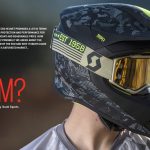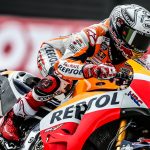2019 FIM Cross Country Rallies World Champion Sam Sunderland throttles his Red Bull KTM Factory Rally 450 past my stationary enduro bike. I’ve stopped and parked to one side of a sunny Catalan trail a short distance outside the town of Igualada, west of Barcelona. I’d like to say I’m waiting for the Brit to catch up…but the truth is that he’s been helping a media colleague and I’ve been free to explore the path with my own version of a ‘roadbook’ mounted on top of the KTM 450 EXC-F: just one of the latest and smallest insights into what an athlete like Sunderland has to deal with in his day job.
The 30 year old drifts around the following corner and disappears. He swiftly becomes nothing but an echo and a settling plume of dust.
In 2017 Sunderland became the first British winner of the fierce Dakar Rally, an annual two-week 9000km chase that began in 1978 and is now heading to its third continent after a decade exploring the peaks, depths and vast topography of South America. In a matter of weeks, the factory Red Bull KTM rider will be in Saudi Arabia as one of the favourites for the contest that has claimed lives, limbs, machinery and souls.
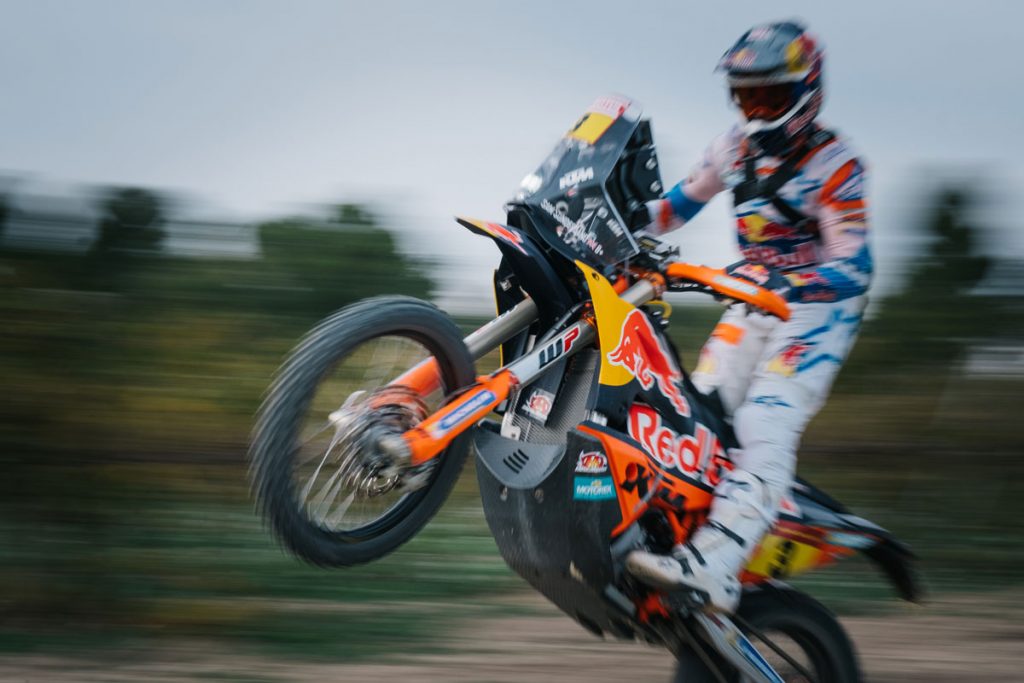
The amiable and articulate athlete from Poole in Dorset, England (not too far from British MXGP venue Matterley Basin) is in the final phases of preparation for the race but has offered the day to show some of the intricacies of rally riding; a discipline that can see more than 500km covered in one stage and often at speeds topping 100mph while taking navigational references from the paper scroll – the roadbook – mounted in a rudimentary plastic box above the bike’s handlebars. Sunderland not only has to be fast, talented and brave but also perceptive, analytical and mechanically ‘aware’. Not to mention boasting a freakish level of stamina and determination. Rally competitors are arguably the definition of complete motorcyclists.
“As a rally rider I think you need to be really good at reading new terrain,” he says earlier in the day and before we’ve found the trails. “Imagine: 100% of the time it’s all new. Every time we come to a blind rise we need to anticipate if it is going left or going right. Does it look a bit gnarly? Can you see a little rain rut coming in from the edge that might be on the other side? You have to pick-up everything and almost have a sixth sense for it. You question everything while riding as fast and as safely as you can.”
Sunderland also has to contend with the Dakar at a time when the opposition has never been stronger with multi-million euro efforts from other manufacturers vying for the top prize. Stage wins and overall success makes the evening news in many countries, especially southern Europe and the Benelux region. It’s a big business for brands that relish the extreme conditions for motorcycle development as much as marketing exposure.
“Now there is KTM, Husqvarna, GasGas, as well as Yamaha and Honda and they all have navigation trainers and big budgets where they will go to similar places to train,” he says. “The level has gone up and up, and it’s good! I like it. I like that it progresses. If you want to win Dakar you need to be more than perfect. You cannot afford to make navigation mistakes because fewer and fewer guys do things like miss a waypoint whereas in the past it was quite common.”
The capability to throw a motorcycle quickly through sand, mud, rocks, dirt, water is just one facet of the job. Sunderland needs to be fit enough for twelve-hour stints in the saddle and cannot lose precious minutes from his overall race time through the stages. In the last three editions of the Dakar the winning margin after two weeks of utter endurance (and great personal risk across a distance that twice covers the breadth of the United States) has been 32, 16 and just 9 minutes.
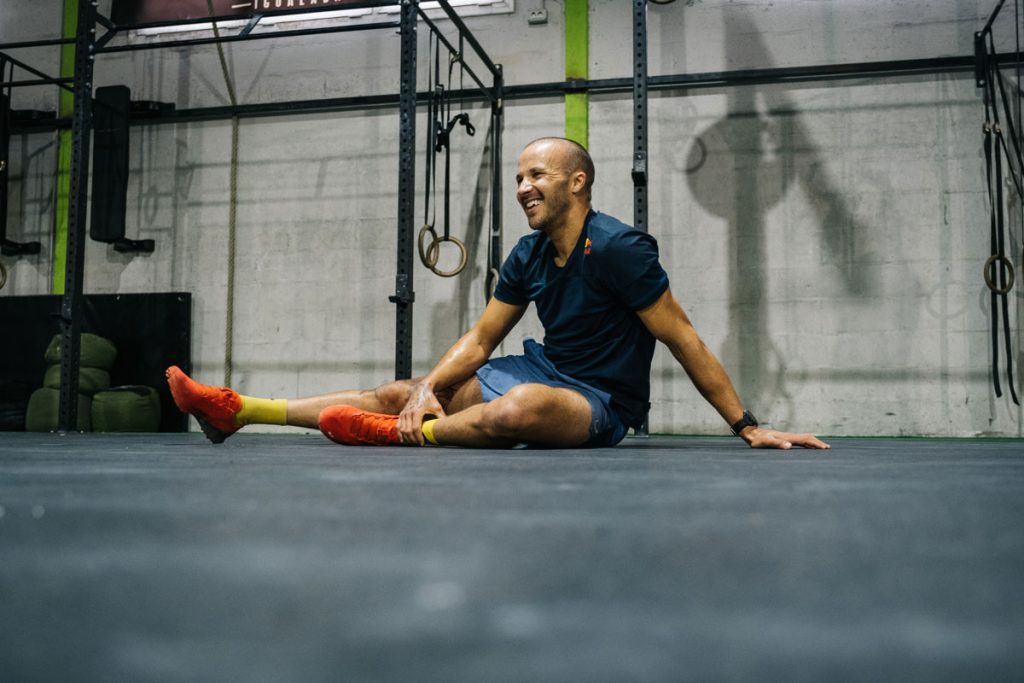
We’ve given a glimpse into the physical side of his training regime. The day starts with a gruelling cross-fit circuit of rowing, lifts, squats and power-cycling stints. Sunderland completes the cycle, although it’s reassuring to see that it’s no cinch for him either. He wanders over when we’re still trying to catch our breath and, surprisingly, explains that intense gym sessions are not his basis of training for rally.
“I think there is some relativity between training in the nature and rally,” he reveals. “Rally is about how fast you can read what’s in front of you and when I’m running in the mountains you have to study everywhere; where you are putting your feet and keep your focus. Compare that to running on a treadmill in the gym where you put your brain in a box and survive how long you want. Outside on foot or a bicycle you are dealing with the elements, you have to keep that concentration and always watch for one rock that can catch you out.”
“When you want to start doing some specific things like getting your back a bit stronger – because you can have a sore back after a few days riding – then it’s beneficial to get in the gym,” he adds. “If you feel that your legs are not strong enough for some of the impacts then you can work on that. Honestly though, 90-95% of my work for fitness is done outside. I like working in the rain and the snow and suffering a bit.”
Suffering seems to be a common theme of chasing Dakar glory, but Sunderland’s preparation is not solely based on becoming a beefcake on a bike. “There is a big mental side to it with the navigation and trying to understand your strategy for the next days as well as the timings while you’re on the bike and on the move,” he says. “I like doing cognitive work while training.”

He seems meticulous, as you’d expect from an athlete of his ilk. “There are a lot of variables in rally…they also change! There are always factors that you can control but a lot you can’t. So, for the ones where you have some influence then you need to have them perfect such as hydration packs, food, prep the night before a stage and constant routines. These are factors that should be beyond question.”
“Once you arrive to the middle of the desert and a place like Merzouga in Morocco it’s not like you can just pop to the stock and buy what you need,” he stresses. “A lot of our stuff is quite specific. You just try to be two steps in front to lighten the workload.”
Sunderland is now somewhat seasoned at the Dakar and a challenge he first affronted as a 22 year old. His debut spluttered to a halt in 2013 due to a mechanical problem while two broken wrists delayed his second attempt. “The Dakar. First time: It was huge,” he says, puffing out his cheeks. “I was a motocrosser, and I got into rally because I was living in Dubai. The first world championship round I did was a five day rally in Abu Dhabi. I was young and raced as hard as I could every single kilometre. When you arrive to something like the Dakar you have to adjust that mentality to do the long-game. The sport has changed so much, now it is so fast.”
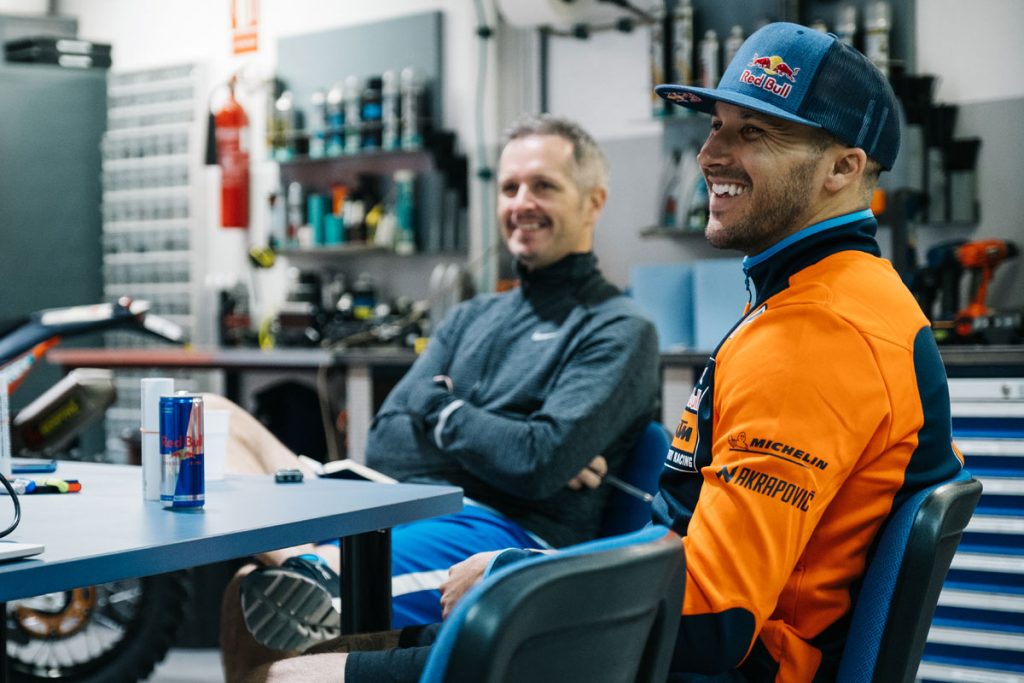
The workshop of Red Bull KTM team manager and former Dakar podium-finisher Jordi Viladoms is located in Igualada and just around the corner from the gym. We walk in and past the immaculate form of the KTM Rally 450 that took Sunderland to the ’19 world title – an international five round mini series of short rallies – and will soon be shipped to the Middle East. “I feel like I know my Rally bike really well, all its in-and-outs, how it reacts and works under braking and traction. I don’t feel I miss much if I am not riding it,” he comments by way of explanation for how much bike mileage enters his training programme. Sunderland hones his feeling between throttle, wheels and dirt thanks to copious laps on a motocross bike and will soon embark on a ten-day riding ‘bootcamp’ in Dubai as the last surge of work before the Dakar.
Viladoms enters the room. He concurs with Sunderland’s view on the evolution of the Dakar. “For the old generation it was not ‘flat-out’ every day. Many times a group would come together at some point. You were all pushing but we’d arrive together, like cyclists, and nobody would push extra because everyone knew it would be so hard to breakaway. It was more about survival. Now from the first kilometre it is full-gas and 100% every minute until someone makes a mistake.”
In the workshop Sunderland gives us the next insight to the demands of the Dakar. On the table before us is a scroll of paper. It’s a roadbook for a 35km course around Igualada. The roll spills out across the floor as we are given three different coloured pens and have to make sense of a series of numbers, arrows, symbols and French acronyms. The paper is easily ten yards in length. Sunderland smiles; sometimes he needs to deal with a roadbook for more than 500km. “It is so big that it won’t fit in the bike, so you have to cut it in two…and make sure you don’t leave the second half in the camp.”
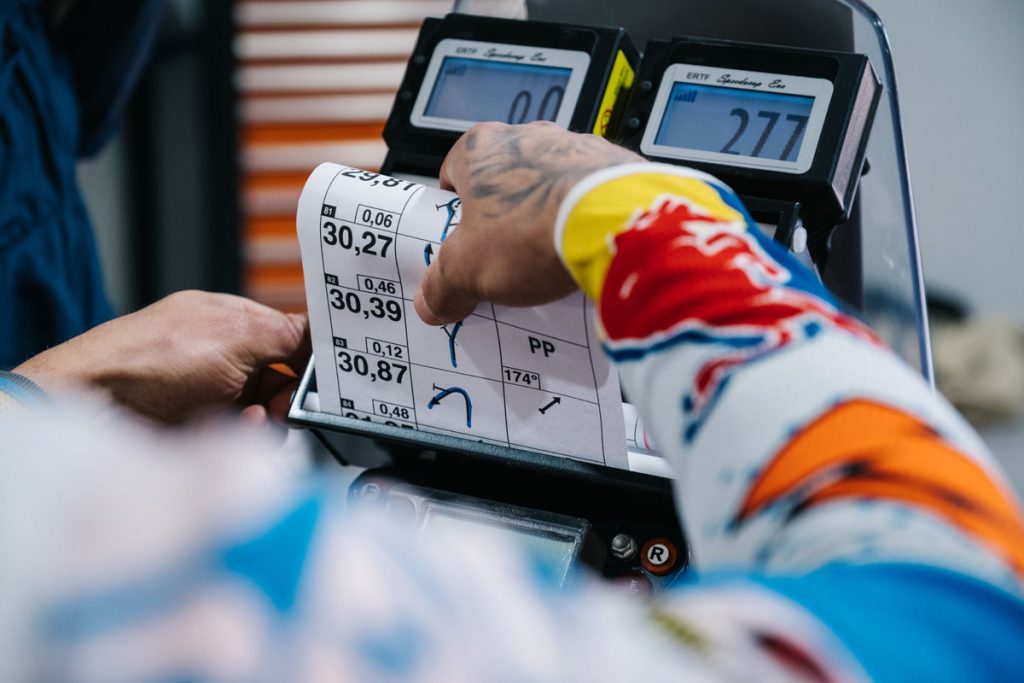
Dakar competitors are given the roadbook before a stage and then colour co-ordinate or ‘paint’ the series of instructions for fast reference. “Everybody has their own system: green might mean ‘turn’, danger is ‘pink’, important information is ‘orange’,” he says. “The worse ones can take up to four hours of marking and work and you have to be super-focussed. We’re racing on the limit and if you don’t paint a danger 3 because you missed it through being tired or you were talking to your friend then it can be a really bad day. Painting is part of the accumulative fatigue. The roadbook is like your bible when you are racing.I don’t want anyone to paint for me; it’s my life out there. I want that on my shoulders.”
Good navigation is nigh-on essential for the Dakar. “The desert can be such a lonely place sometimes when you are lost,” laments Sunderland who first tackled the Dakar in 2011. It is also an element of racing in which that teams invest heavily. They train and use specialists. “Every team has a Google Maps guy. When we get the roadbook for a 500km stage then we plot it out on Google Earth and have a look. We know more or less where we are going but the stages are too long. You’ll remember so little when you start to set out.”
But what are the basic mechanics of Dakar stage route-finding? “We have a GPS on the bike – but that is normally ‘closed’ – so we navigate through roadbook and kilometres and CAP [compass],” Sunderland says. “As soon as you get inside the radius of a waypoint marker [WPM] then it opens and guides you in with an arrow for the last 800m and then you validate it. So hitting a WPM is quite easy but in the last three-four years there have been more waypoint controls, WPCs, which has only a 300m radius and it doesn’t open, it just changes a small number in the GPS: so, you don’t know at which point you catch the ‘area’ before your next turn. You might be on the borderline of catching the next one through some horrendous terrain and it increases your chances of getting lost.”
“You end up looking down and thinking ‘s**t, why hasn’t it validated?’ and you start to do a figure of eight looking for it. Then you start going backwards. The goal is to always ride with a good CAP. WPC to WPC is really scary because you don’t know where you are starting from. And there is no way to know. You just have to hope you have done good. Quite often you’ll use references. If you know you have a good CAP and you look left and see a big dune peak then I claim it as my reference and push like hell until I get to a certain point and then take another CAP reading and look for another peak. That’s an ideal world.”
The explanation sounds tiring already.
“In a long stage with a lot of ‘off-piste’ then there can be up to a hundred waypoints,” he adds. “Dunes are so up-and-down and they look so similar. If you think you are near where you should be and there is no ‘opening’ on your dash then that’s the worst feeling ever, and you just want to start praying to every single god that there is.”
Frequently images of the Dakar show riders bunched within view of each other: surely through the sand there are tracks of rivals to follow?
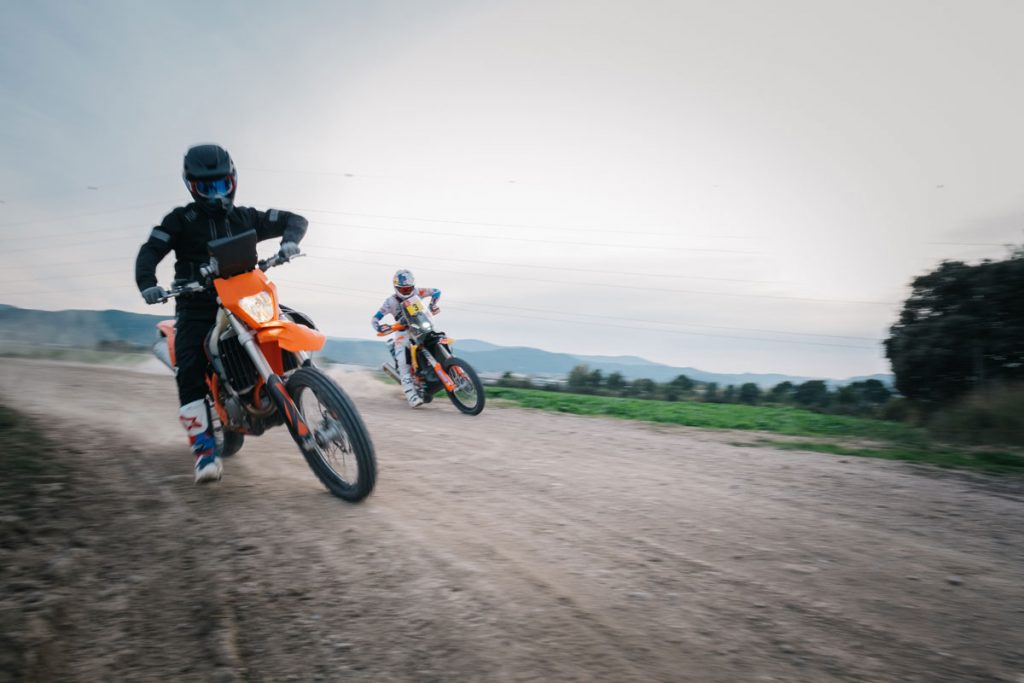
“The first guy that sets off in a stage, especially on sand, is at a huge disadvantage, in general, because he’s the first one to come across any situation and wherever he goes he leaves a little black line as a reference,” Sunderland admits. “But now the level is so high that there are many guys that can open a stage and almost be uncatchable. There is also a lot of strategy involved. There are some riders who are better than others at navigation and you can trust them more, so you see their tracks and just gas it. That’s why it is important to know who is opening the stage and to know how much confidence you can have.”
“Sometimes people try and do sneaky things, like riding the wrong way and confusing the guys behind…but then it gets a bit tricky,” he grins. “The first guy opening a stage has the responsibility of the whole race on his shoulders in some way. Sometimes he can get lost. So, you constantly have to check and make decisions. If there are ten days in Dakar and stage four is sand and is really difficult then nobody wants to win day three!”
Sunderland has tasted the utter dejection of losing his way among a complicated process of hitting waypoint markers and controls. “In my first Dakar with KTM I won Stage 1, and Stage 2 was 470km and I was doing super-good but in the last 30ks of the stage I got lost for two hours. I was devastated. I arrived like a drunk person. You are dehydrated and you are mentally fatigued because you’ve been riding many hours and you are not as mentally alert as you should be. The urgency to try and get to the finish and not let the whole stage go downhill means you make rash decisions.”
Painted and coloured between warnings and directions my roadbook is wound into place through the box on the KTM and with the November sun working wonders, we start to ride. Concentrating on the road and path while electronically spooling the roadbook with my left thumb – thanks to a small switch under the handlebar – and interpreting the notes is a mind-boggling feat of multi-tasking. After about 10km it’s possible to get a bit of a rhythm. I spend less time looking down and become quicker with the winding.
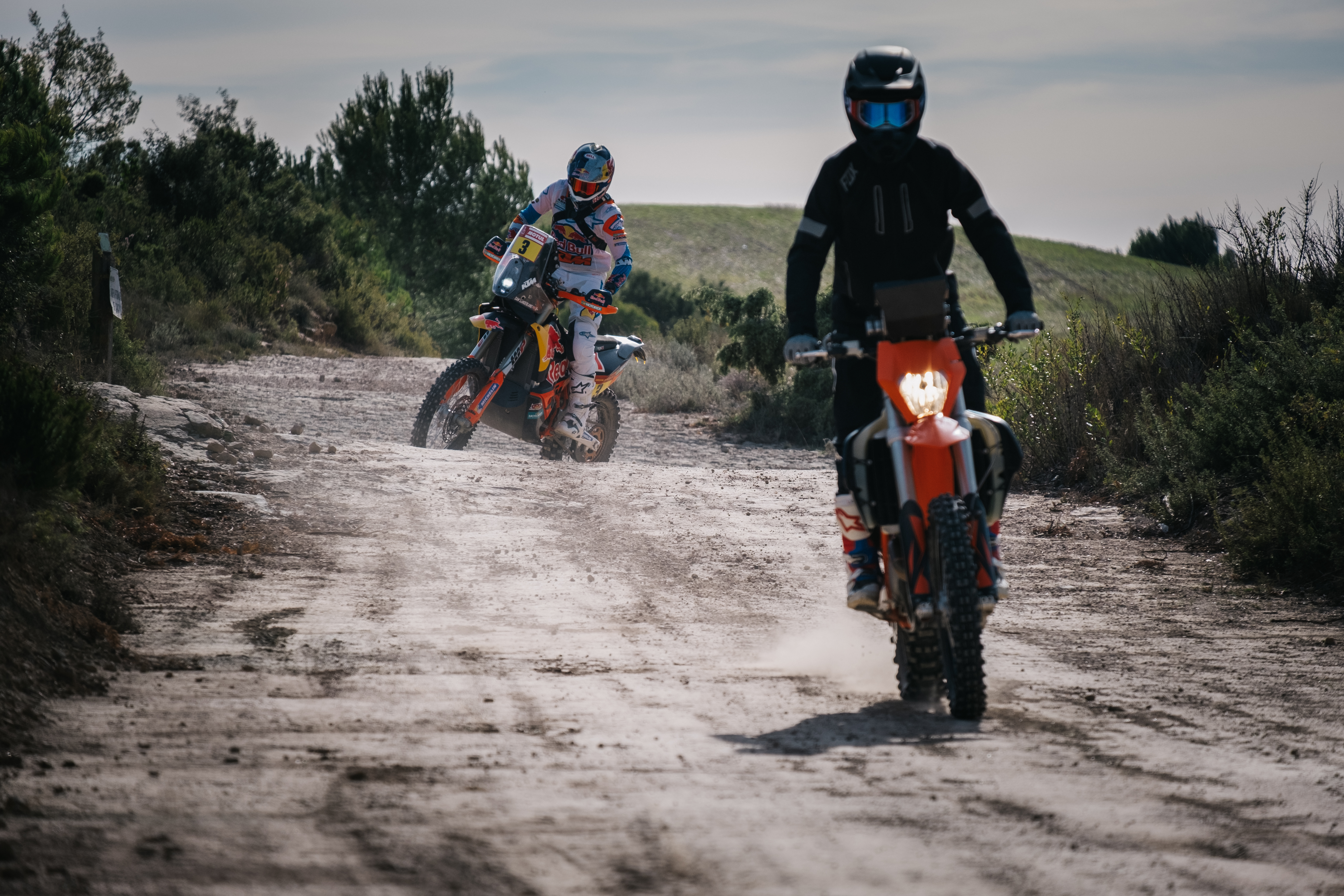
This swift blast is the equivalent of a run to the local shop for Sunderland. Conquering tiredness and fighting his own performance demons is another component of the Dakar. Thankfully it is an experience we don’t have to taste but our riding companion – who snapped his femur rallying less than three months before the 2016 edition and had to watch it from his sofa – is able to elucidate. “The team can do as much as they can and be absolutely perfect but from something like 3am until 4pm it’s all on you: ‘there’s your bike, have a good day.’ You cannot make any mistakes. You get so tired. The accumulative side is horrendous. You start slacking.”
“The first three days always seem really hard, then once you get past day four – and as long as nothing has happened like picking up a small injury or suffering a drama – then you kinda get in the swing of it,” he shrugs.
“Often it is the tough moments where you find out a lot about yourself,” he reflects. “I remember one Dakar there was a really long stage and I made a navigation error quite close to the finish. I had been racing for seven hours and it was fifty degrees. I had no water left in my CamelPak and I was beyond destroyed. I was shivering despite the temperature and felt confused. I wasn’t really sure what was going on. In those moments you are not really sure what is good for you in a way. I could have stopped and called for help, but you don’t do that…it is the very last resort for a rider. I think in those moments you rediscover how far you can go to survive [in competition] and it is not nice but sometimes you end up in those positions because you have messed-up or made a mistake. Quite often you see what you are made of. In Rally you are against the elements: It can be really hot, really cold, really high. You can be 5000m up in Bolivia and it’s -2 and then suddenly in 45 degrees in the Dunes in Argentina. You definitely pass through some rough moments that make you look at life quite differently in some senses.”
“In the end it’s about risk management because you are going so fast. How much do you want to push the boundaries and miss a moment of danger? Once you are in it then you are in a state of flow and focus where it is something you don’t have to think about. It’s really nice.”
Despite the lengthy, drawn-out nature of Rally, in reality the stresses coupled with the pressure, expectation and spotlight for a rider of Sunderland’s status makes for a dizzying, intense and fraught existence. Then, of course racing is not the same as leading.
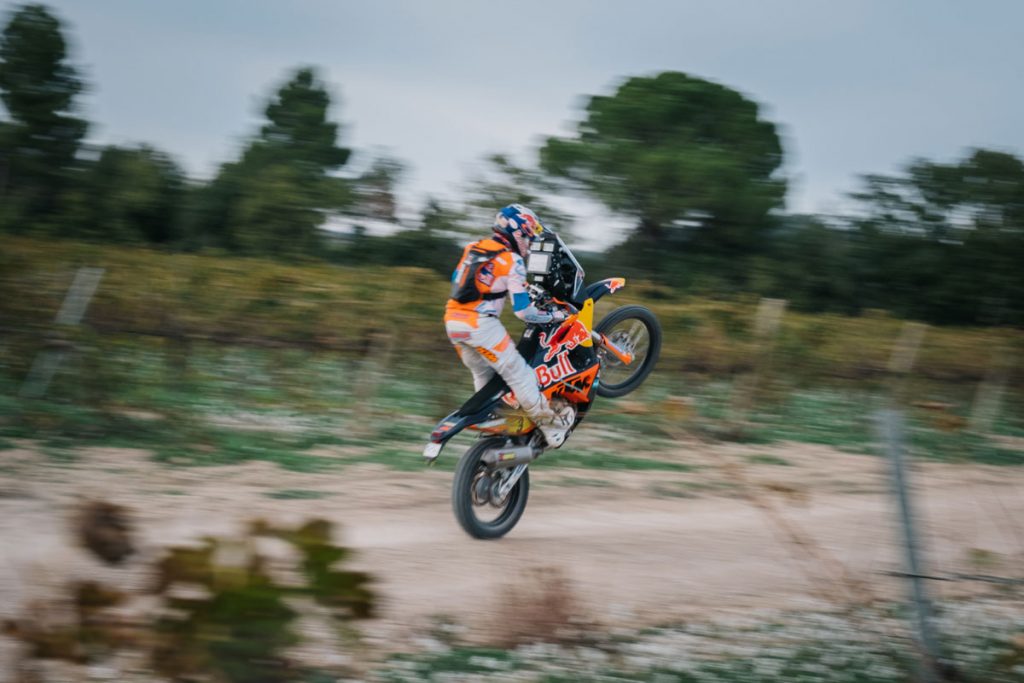
“When I was leading the Dakar I found it even more difficult because I was trying to ‘manage’,” he says. “It’s funny, when you are second then all you are thinking about is how you can win and how you can get to the front. But as soon as you are leading you start thinking ‘how do I not lose this?’ All these ideas come into your head of ‘this or that could happen’. It’s difficult then to stay on-point with the mental side and not have any doubts or worries. You are on your own all day. In the Bivouac you have your team and team manager and others around you that can reassure you. We human, not robots. There is this race that you have worked so much for and the team and manufacturer have put in so many hours and budget and effort. You feel pressure and responsibility and if you do something stupid then it’s ‘on you’.”
“I remember feeling really tired when I was leading Dakar and that was from day five to fourteen; I was so emotionally drained. It was like I had this ‘baby’ I was trying to protect from danger. And everyone is watching you and people are looking out for the smallest mistake. If you enter the time boards too early then bang! A penalty. If your mechanic hands you a water outside of the zone then it’s ‘outside assistance’. You try not to worry but you are in protection mode and any little mistake feels so much bigger than perhaps it really is.”
Returning to base for lunch and Sunderland is chipper. He’s in good shape and Red Bull KTM are clearly the leading team at Dakar. His ’17 success is one of eighteen in a row now for the Austrians. Saudi Arabia is a new landscape for a race that becomes the centre of attention in the motorcycle racing community for a fortnight in January. “It’s a clean slate for everyone,” he enthuses. “I feel that South America has been discovered. This one will be tough on the bikes, tough physically, tough mentally and I hear we’ll have really long stages – 500-odd kilometres some days – it’s a good thing!”
All the gear…
So far, the recently overhauled ‘second generation’ of Fox’s Legion Enduro riding gear is some of the best I’ve worn on a dirt bike.
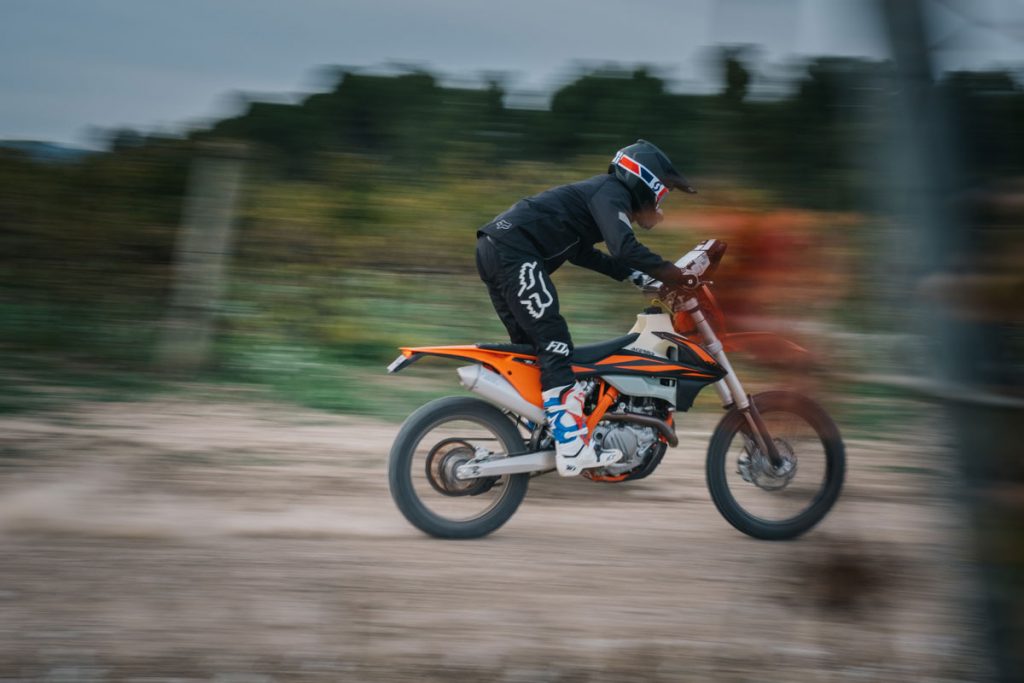
The Americans’ released the initial Cordura-laced kit three years ago and pegged it towards the off-road user seeking extra resistant material but with the performance properties of motocross and more towards their featherlight FlexAir. The first Legion collection was impressive. It was light for the durability it offered (I remember scraping my way through trees and foliage at Dave Thorpe’s Honda riding school in Wales and was surprised by the lack of marks or deformation on the jersey arms in particular). The 2020 kit I used in Igualada is a step further towards FlexAir. It weighs barely anything, is still heavily mixed with Cordura and the fitting is sportier and less rigid compared to the first lines due to Fox’s TruMotion 4-way stretch material.
I’ll admit to loving the original blue/orange colourway – especially when combined with the same colours in the Instinct boot – and the 2020 black/grey jacket, shirt, pant and glove combo was too conservative if admirably neutral. The new Fluid tech V3 completed the look and even if the fit felt very narrow at first then the ventilation properties of the helmet were noticeably good; it was sunny but as the day neared dusk then the cooler air meant that our final blast back to the Viladoms workshop on the road was pretty chilly.
I was lucky enough to use the best goggles on the market – Scott’s Prospect – and a tinted lens with TruView technology meant it was a breeze to keep an eye on the loose gravel along the faster stretches of the trail. There wasn’t a single doubt about wearing any other eyewear; even Sam’s Oakley AirBrakes looked less capable than the Prospect.
By Adam Wheeler @ontrackoffroad
Photos by Riki Rocket/Red Bull

